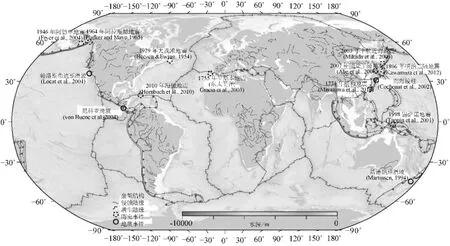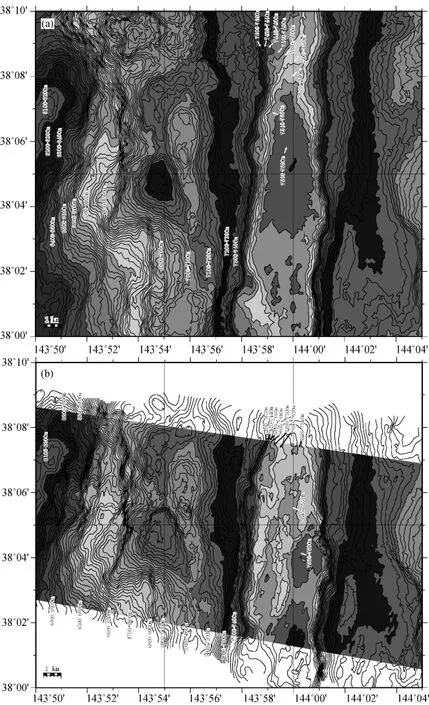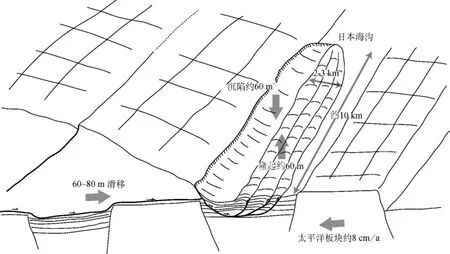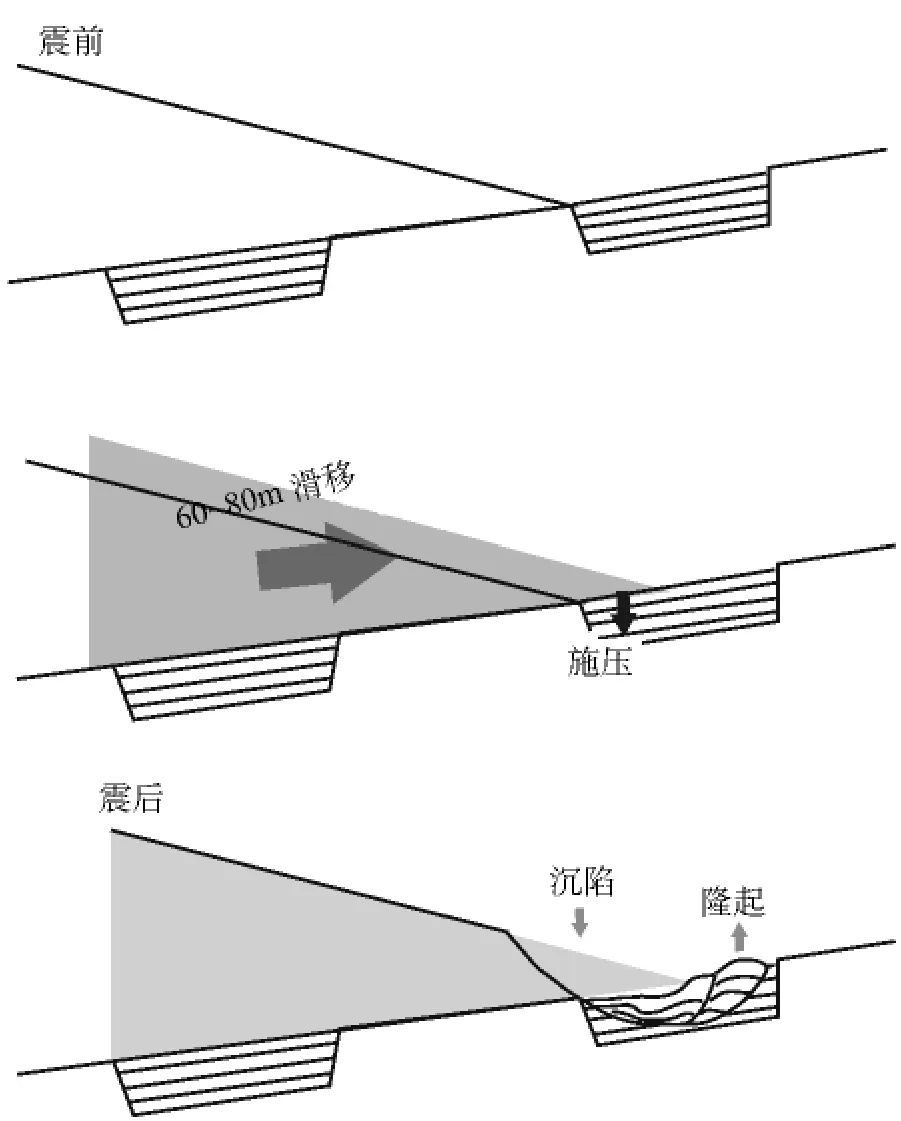活跃陆缘可致海啸的海底滑坡
2015-12-24KiichiroKawamuraJanSverreLabergToshiyaKanamatsu
Kiichiro Kawamura Jan Sverre Laberg Toshiya Kanamatsu
0 引言
由于海底滑坡对海底设施以及沿岸居民具有潜在的直接和/或间接影响,其被视作最重要的海洋地质灾害之一,并且这已被近期的例子所说明。1998年7月17日,在巴布亚新几内亚(PNG),约有2 200人死于海底滑坡导致的毁灭性海啸,此滑坡被认为由MW7.1地震所致(Tappin et al,2001,2008;图1)。
上例说明海底滑坡可能诱发海啸。海底滑坡机制与地震、活动断层的性质、位置以及大陆坡沉积物破坏前的特性密切相关。尽管模拟结果表明沉积物的流动特征相当重要,但所破坏沉积物的流动行为、体积和初始加速度目前仍知之甚少(Locat and Lee,2002)。活跃陆缘的海底滑坡可由地震触发,但目前对多种滑坡机制仍在探讨之中,包括地震导致的液化和地面加速度(Sultan et al,2004)、断层运动导致的斜坡直接破坏(Yamada et al,2010)和/或沿断层的液体排出(Bangs et al,2010)。
本文着重分析众多活跃陆缘上已被调查过的海底滑坡,既包括地质记录中保存的大型海底滑坡(如帕洛斯弗迪斯滑坡),也包括有史以来的实例(如1998年锡萨诺地震)。然后,我们描述海底滑坡与地震之间的关系以及如何从海底滑坡沉积中揭示古地震活动。最后我们考虑在无地震活动触发的情况下是否可发生海啸和海底滑坡。

图1 活跃陆缘主要海底滑坡地理位置图。来自于历史记录的用虚线圆表示,来自于地质记录的用实线圆表示。Clift与Vannucchi(2004)区分开了增生陆缘(蓝实线)和侵蚀陆缘(蓝虚线)。侵蚀陆缘多数相当于Ruff(1989)所述的垒堑结构(HGS)的俯冲海洋板块(原图为彩色图——译注)
1 活跃陆缘可致海啸的海底滑坡
1.1 地质记录中可致海啸的大型海底滑坡
最近,Lo lacono等(2012)描述了北戈林奇滑坡。在伊比里亚陆缘西南的戈林奇浅滩北侧发生的这次滑坡体积约80km3,滑移了35km(图1)。他们认为类似规模的海底滑坡会产生波高超过15m的海啸波,约30分钟后该海啸波就可抵达葡萄牙南岸。
在哥斯达黎加汇聚陆缘,von Huene等(2004)研究了尼科亚滑坡,据估计该滑坡体积可达10km3(图1),由海山俯冲/碰撞造成。此地虽未发现实际海啸,但若此类滑坡并非单一事件,即可预测产生了27m高的海啸(von Huene et al,2004)。在南海增生楔东部,对这种与海山俯冲/碰撞相关的海底滑坡已有研究(Cochonat et al,2002;Kawamura et al,2011)并利用砂箱模拟试验重构过(Domingues et al,2000)。
Bohannon和 Gardner(2004)讨论了洛杉矶近海的帕洛斯弗迪斯滑坡(图1),推断该滑坡可追溯到距今7 500年以前。该滑坡长4.5km,宽8km,可能导致了约12m高的海啸。根据斜坡稳定性分析,Locat等(2004)的研究表明该滑坡由一次7级地震触发。
1.2 历史记录中可致海啸的海底滑坡
相对地质记录而言,历史记录中有大量可致海啸的海底滑坡记载。
1755年11月1日,葡萄牙近海的圣维森特断层发生了约MW8.5的里斯本地震(图1)。强海啸使里斯本以及欧洲和非洲的北大西洋沿海均成为废墟。Gracia等(2003)的研究表明,海啸可能由逆冲断层上盘的海底滑坡引起。
1771年明和海啸是由4月24日的地震引起的,袭击了琉球群岛南部(Miyazawa et al,2012;图1)。在一些区域,海啸的最大爬高可达30m,但大部分沿海地区低于10~15m(Miyazawa et al,2012)。这一罕见的海啸被认为由发生在琉球海沟向陆坡的海底滑坡导致(图1)。
1964年3月27日发生的一次MW9.2的地震在阿拉斯加引发了一场(Mt)9.1的强海啸(Abe,1979;图1)。Plafker和 Mayo(1965)描述了由河流三角洲、终碛等发生的水下滑坡所触发的局部海啸波。该海啸约高3.0~4.5m,在震后19~20min内袭击了众多海湾区域。
1998年7月17日,在一次MW7.1地震之后产生的最大浪高15m的海啸淹没了巴布新几内亚的锡萨诺(Kawata et al,1999;图1)。基于详细的海底测绘数据,Tappin等(2001,2008)断定强海啸是由泻湖离岸区的海底滑坡所致。该海啸由地震迅速激发(Newman and Okal,1988),但却由随后的海底滑坡所产生(Tappin et al,2008)。
2007年3月25日,位于日本西北部的能登半岛附近发生了MW6.7能登半岛地震(Abe et al,2008;图1)。尽管海啸在震后一小时才抵达海岸,但仍有一些地方记录到了异常潮波,这被认为是海底滑坡所致(Abe et al,2008)。
2010年1月12日,MW7.0的海地地震显示的主要是走滑运动,但仍触发了海啸(Hornbach et al,2010;图1)。该地震导致多个河流三角洲发生液化现象,并且液化迅速加剧导致了破坏。据断定,该地震在沿海岸线的一些位置导致了可致海啸的海底滑坡。
总之,所有这些由海底滑坡导致海啸的历史案例都源于地震活动。我们从这些案例中可知,目前为止并不是所有海啸事件都直接由地震时的破裂扩展以及断层位错造成。
2 斜坡稳定性分析的古地震
利用 Urgeles等(2006)和Strasser等(2007)给出的事后分析计算斜坡稳定性时,我们需要评估古地震活动和/或对未来地震预测的地震活动。对前人有关斜坡稳定性破坏机制的量化研究综述如下。
1929年11月18日,纽芬兰南部发生了一次面波震级(MS)7.2的地震(图1)。12条海底电缆被浊流切断,这缘于上陆坡发生的海底滑坡(Heezen and Ewing,1952)。大浅滩滑坡块体运动的最大速度可能达到70m/s(Canals et al,2004)。Clague 等(2003)报告说,发生在纽芬兰由地震导致的海啸浪高达3.0~7.5m。可致海啸的海底滑坡的数值模拟与这些观测数据一致(Fine et al,2005)。
Mikada等(2006)利用在日本千岛海沟布设的海底电缆系统观测了一次正在发生的浊流。这次由N-NE到S-SW的浊流流速高于1m/s,厚度约为 60m(Mikada et al,2006)。根据他们的研究,此次浊流缘于2003年9月25日19∶50(世界标准时间)十胜近海MW8.1地震导致的斜坡破坏,并且这是地震浊流的第一次实时观测。类似的地震浊流在相模海槽(Kasayaet al,2009)和日本海沟(Arai et al,2013)也曾观测到。
2009年8月11日,日本骏河湾海床以下23km发生了一次MW6.4的地震(图1)。Matsumoto等(2012)利用基于地震前后所采集数据的微分等深图,探测到水深在斜坡区域下降,在下坡盆地区域上升。他们(利用潜水器)也发现斜坡区的水管系统遭到破坏,并断定此处发生过地震海底滑坡。该滑坡破坏了水管,使沉积物在下坡盆地沉积,并造成海啸。他们的研究结果有助于我们理解海底滑坡发生所需的定量条件。
3 海啸地震抑或海底滑坡?
沿汇聚陆缘发生弱震后,也记录到过强海啸,地震学家将此类事件称为海啸地震或者慢地震(如Kanamori,1972)。然而,其中有些也可能是海底滑坡的结果(Kanamori and Kikuchi,1993;Tappin et al,2001;Fryer et al,2004;Tappin et al,2008;Kawamura et al,2012)。因此,我们应谨慎评估海底滑坡对海啸的贡献程度以及可致海啸的海底滑坡在 “海啸地震”中的产生概率。有几个未研究透彻的海啸地震事件仍旧存疑,下文详述。
3.1 1896年明治三陆地震与海啸
1896年6月15日,明治三陆地震尽管只是MS7.2,地震烈度也较小,但产生了最大波浪爬高37m的毁灭性海啸,造成了日本历史上最严重的海啸灾难(Tanioka and Satake,1996)。Abe(1979)研究表明尽管地震的面波震级(MS)较低,但海啸的大小等级(Mt)高达8.6。为了解释地震面波震级与海啸大小等级之间的差异,1896年三陆地震被归因于沿断层的缓慢破裂(Kanamori,1972)、海底滑坡(Kanamori and Kikuchi,1993)以及沉积楔的附加迅速堆积(Tanioka and Seno,2001)。Kawamura等(2012)在地质结构与地形分析的基础上,支持海底滑坡诱因假说,这在先前的构造侵蚀研究中多有涉及(如von Huene and Lallemand,1990;图1)。
3.2 1946年阿留申地震与海啸
1946年4月1日发生的MS7.1地震(Fryer et al,2004),导致了Mt9.3的强海啸,造成阿拉斯加沿海167人丧生。Fryer等(2004)提出海啸由海底滑坡(尤加马克滑坡;图1)造成,其滑坡前缘在沿岸区水下约200m处。不过,Rathbum等(2009)断定被认为是 “尤加马克滑坡”的地质特征根本就不是滑坡,也并非由1946年大地震所致。
3.3 2011年东北近海地震与海啸
2011年3月11日在日本海沟发生MW9.0地震(Ide et al,2011),是由北美板块(西北日本岛弧)与太平洋板块边界处的大规模逆冲滑动造成。据估计,地震时沿逆断层的滑移错位达60~80m(Fujiwara et al,2011;Ito et al,2011),但该错位看来太大,而不能由一次地震的逆冲造成。Kawamura等(2012)认为大型海底滑坡是此次滑移的主因,但存在不确定性(Romano et al,2012)。解释这次大滑移错位仍存在几个假说,包括过冲假说(Ide et al,2011)。
Strasser等(2013)利用微分测深调查、地震勘察和活塞取样等方法研究了2011年东北近海地震的海啸源。他们描述了海啸源区大规模的60m隆起和60m沉陷(图2)。我们认为这种测深差别是由发生在楔脚的长10km、宽2~3km的海底滑坡所致(图3)。这些海底滑坡的发生机制可用斜坡失稳导致的楔脚滑塌解释(图4)。楔脚被推至60m或80m远的松散海沟充填沉积物上,对其迅速施压,致使楔脚垮塌(图4)。所以,当破裂沿逆断层扩展至海沟时,海沟充填沉积物能导致楔脚处发生海底滑坡,如2011年东北近海地震的情况就是如此(Kodaira et al,2012)。
4 活跃陆缘可致海啸的海底滑坡预处理因素
通常,海啸由海底迅速变形所致,变形引起海水运动而产生海啸。2011年东北近海地震中,诱发海啸的海底变形发生在日本海沟的前楔(Maeda et al,2011)。虽然破裂扩展持续了约2分钟(Ide et al,2011),但诱发海啸的海底变形至少持续了4分钟(Satake et al,2013)。在与1896年明治三陆地震相同的海啸源区,没有破裂扩展的条件下海底变形持续了约2分钟(Satake et al,2013)。

图2 在2011年东北近海地震海啸源区的日本海沟底部的微分测深图,(a)为1999年的结果,(b)为2011年的结果(原图为彩色图——译注)。等高距20m。1999年日本海沟底部海床面较平坦,但2011年的数据显示,此处有约10km长、2~3km宽的约60m的隆起。向陆坡的紫色区(西侧)2011年比1999年变小了。这片区域对应Strasser等(2013)的沉陷区

图3 日本海沟构造侵蚀环境下发生于活跃陆缘的海底滑坡图解,以2011年东北近海地震为例。日本海沟的海底滑坡滑移至海沟轴充填了地堑。构造侵蚀可进一步引起后退式海底滑坡,并触发海啸

图4 以2011年东北近海地震为例的日本海沟海底滑坡原理模型(Strasser et al,2013)。因斜坡失稳,楔脚滑至海沟,迅速施压给海沟底部的松散沉积物(Strasser et al,2013)。Yamada等(2010)认为增生陆缘柱脚部位海底滑坡具有相同机制
运用地震波反演分析,先前的研究发现在24km深的震源处有约20m的滑移。Ito等(2011)研究指出,该震源20m的滑移在海床面则增大到80m的滑移。通常,破裂扩展过程中,沿断层的滑移量应随距震源的距离增大而减小。此处滑移为何随着深度的减少而增多呢?Ide等(2011)认为2011年东北近海地震期间,在前缘楔发生了动态过冲的浅层相对平静的破裂,而Kawamura等(2012)认为大规模的正断层形成了滑脱构造,可能对浅层区造成额外的断层滑移。
在这种情况下,如果上盘的沉积物不稳定,地震和/或破裂扩展就会触发海啸(图3,图4)。破裂扩展可能并非海啸发生的主因,而只是一种触发因素。基于2011年东北近海地震/海啸的证据,向陆海沟斜坡的稳定性理应决定着海啸的规模。
2011年东北近海地震期间发生在前缘楔的60m或80m滑移可用海底滑坡解释为附加海啸源(Kawamura et al,2012)。
5 讨论
正如上文所述,此类滑坡的触发机制多与地震有关,尤其是位于无增生的汇聚陆缘的可致海啸的海底大滑坡(Ruff,1989;Clift and Vannucchi,2004;图1);例如日本海沟(1896年明治三陆地震和2011年东北近海地震)、琉球海沟(1771年明和海啸)和哥斯达黎加陆缘(尼科亚滑坡)。这些海啸可能由大型海底滑坡所引起,并与构造侵蚀和/或汇聚陆缘俯冲海洋板块上的垒堑构造相关(图4)。事实上,日本海沟的此类海底滑坡已如Taira和Ogawa(1991)所述观测到并阐述过。
先前认为,除了火山和/或小型滑坡的局部效应外(Plafker and Mayo,1965),海底滑坡仅由活动断层作用导致的海底地形变化所引起。然而,可致海啸的海底滑坡已知可在世界不同地区发生。因此,所有关于海啸发生机制以及海啸地震——如2011年东北近海地震——前后地形变化的资料均应细致检查,以提高人们对海啸产生的理解。
一些东北地方的居民称历史上的东北海啸为尤达(yoda),这对海啸而言另有寓意,意指海啸并非总由强地震所引起(Yoshimura,2004)。这些事件不仅包括1896年明治三陆地震,也包括1960年造成海啸横扫太平洋的智利地震。尽管有文档记录在案,但由于海啸仅能由海底变形和破裂扩展所致的信条,此类尤达事件发生的可能性近期仍被忽视。我们必须迅速重新考虑海啸触发的基本机制,否则面临的可能性就是未将海底滑坡导致海啸情形考虑在内的日本海啸预警系统可能不足以处理潜在海啸情形的整个范畴。
6 结论
1)活跃陆缘环境中海底滑坡的首要触发机制被认为是地震活动。然而,也有一些包括海底滑坡产生在内的可能发生机制的其他假说。
2)可致海啸的大型海底滑坡多发生在非增生的陆缘。
3)这些观测结果对海啸预警系统有一定的借鉴意义,因为日本的海啸预警系统尚未考虑海底滑坡触发海啸的情形。
Abe,K.,1979.Size of great earthquakes of 1837-1974inferred from tsunami data.Journal of Geophysical Research 84,1561-1568.
Abe,I.,Goto,K.,Imamura,F.,Shimizu,K.,2008.Numerical simulation of the tsunami generated by the 2007Noto hanto earthquake and implications for unusual tidal surges observed in Toyama Bay.Earth,Planets and Space 60,133-138.
Arai,K.,Naruse,H.,Miura,R.,Kawamura,K.,Hino,R.,Ito,Y.,Inazu,D.,Yokokawa,M.,Izumi,N.,Murayama,M.,Kasaya,T.,2013.Tsunami-generated turbidity current of the 2011 Tohoku-oki earthquake.Geology 41,1195-1198.http://dx.doi.org/10.1130/G34777.1.
Bangs,N.L.,Hombach,M.J.,Moore,G.F.,Park,J.-O.,2010.Massive methane release triggered by seafloor erosion offshore southwestern Japan.Geology 38(11),1019-1022.http://dx.doi.org/10.1130/G31491.1.
Bohannon,R.G.,Gardner,J.V.,2004.Submarine landslides of San Pedro Escarpment,southwest of Long Beach,California.Marine Geology 203,261-268.
Canals,M.,Lastras,G.,Urgeles,R.,Casamor,J.L.,Mienert,J.,Cattaneo,A.,De Batist,M.,Haflidason,H.,Imbo,Y.,Laberg,J.S.,Locat,J.,Long,D.,Longva,O.,Masson,D.G.,Sultan,N.,Trincardi,F.,Bryn,P.,2004.Slope failure dynamics and impacts from seafloor and shallow sub-seafloor geophysical data:case studies from the COSTA project.Marine Geology 213,9-72.
Clague,J.J.,Munro,A.,Murty,T.S.,2003.Tsunami hazard and risk in Canada.Natural Hazards 28,433-461.
Clift,P.,Vannucchi,P.,2004.Controls on tectonic accretion versus erosion in subduction zones:implications for the origin and recycling of the continental crust.Reviews of Geophysics 42,RG2001.http://dx.doi.org/10.1029/2003RG 000127.
Cochonat,P.,Cadet,J.-P.,Lallemant,S.J.,Mazzotti,S.,Nouze,H.,Fouchet,C.,Fauchet,J.P.,2002.Slope instabilities and gravity processes in fluid migration and tectonically active environment in the eastern Nankai accretionary wedge(KAIKO-Tokai'96cruise).Marine Geology 187,193-202.
Domingues,S.,Melville,J.,Lallemand,S.E.,2000.Deformation of accretionary wedges in response to seamount subduction:Insights from sandbox experiments.Tectonics 19,182-196.
Fine,I.V.,Rabinovich,A.B.,Bornhold,B.D.,Thomson,R.E.,Kulikov,E.A.,2005.The Grand Banks landslide-generated tsunami of November 18,1929:preliminary analysis and numerical modeling.Marine Geology 215,45-57.
Fryer,G.J.,Watts,P.,Pratson,L.F.,2004.Source of the great tsunami of 1April 1946:a landslide in the upper Aleutian forearc.Marine Geology 203,201-218.
Fujiwara,T.,Kodaira,S.,No,T.,Kaiho,Y.,Takahashi,N.,Kaneda,Y.,2011.The 2011Tohoku-Oki earthquake:displacement reaching the trench axis.Science 334,1240.http://dx.doi.org/10.1126/science.1211554.
Gracia,E.,Danobeitia,J.,Verges,J.,P.A.R.S.I.F.A.L.Team,2003.Mapping active faults offshore Portugal(36°N-38°N):implications for seismic hazard assessment along the southwest Iberian margin.Geology 31(1),83-86.
Heezen,B.C.,Ewing,M.,1952.Turbidity currents and submarine slumps,and the 1929Grand Banks earthquake.American Journal of Science 250,849-873.
Hornbach,M.J.,Braudy,N.,Briggs,R.W.,Cormier,M.-H.,Davis,M.B.,Diebold,J.B.,Dieudonne,N.,Douilly,R.,Frohlich,C.,Gulick,S.P.S.,Johnson III,H.E.,Mann,P.,McHugh,C.,Ryan-Mishkin,K.,Symithe,S.J.,Taylor,F.W.,Templeton,J.,2010.High tsunami frequency as a result of combined strike-slip faulting and coastal landslides.Nature Geoscience 3,783-788.
Ide,S.,Baltay,A.,Beroza,G.C.,2011.Shallow dynamic overshoot and energetic deep rupture in the 2011Mw 9.0Tohoku-Oki earthquake.Science 332,1425-1429.
Ito,Y.,Tsuji,T.,Osada,Y.,Kido,M.,Inazu,D.,Hayashi,Y.,Tsushima,H.,Hino,R.,Fujimoto,H.,2011.Frontal wedge deformation near the source region of the 2011Tohoku-Oki earthquake.Geophysical Research Letters 38,L00G05.http://dx.doi.org/10.1029/2011GL 048355.
Kanamori,H.,1972.Mechanism of tsunami earthquakes.Physics of the Earth and Planetary Interiors 6,346-359.
Kanamori,H.,Kikuchi,M.,1993.The 1992Nicaragua earthquake:a slow tsunami earthquake associated with subducted sediments.Nature 361,714-716.
Kasaya,T.,Mitsuzawa,K.,Goto,T.,Iwase,R.,Sayanagi,K.,Araki,E.,Asakawa,K.,Mikada,H.,Watanabe,T.,Takahashi,I.,Nagao,T.,2009.Trial of multidisciplinary observation at an expandable sub-marine cabled station “off-Hatsushima Island Observatory”in Sagami Bay,Japan.Sensors 9,9241-9254.
Kawamura,K.,Ogawa,Y.,Hara,H.,Anma,R.,Dilek,Y.,Kawakami,S.,Chiyonobu,S.,Mukoyoshi,H.,Hirano,S.,2011.Rapid exhumation of subducted sediments from the seismogenic zone along an out-of-sequence thrust in an active accretionary prism,Nankai Trough(Japan).In:Ogawa,Y.,et al.(Eds.),Accretionary Prisms and Convergent Margin Tectonics in the Northwest Pacific Basin:Submersible Studies and Recent Advances.Modern Approaches in Solid Earth Sciences,8.Springer,pp.215-228.
Kawamura,K.,Sasaki,T.,Kanamatsu,T.,Sakaguchi,A.,Ogawa,Y.,2012.Large submarine landslides in the Japan Trench:a new scenario for additional tsunami generation.Geophysical Research Letters 39,L05308.http://dx.doi.org/10.1029/2011GL050661.
Kawata,Y.,Benson,B.C.,Borrero,J.L.,Davies,H.L.,deLange,W.P.,Imamura,F.,Letz,H.,Nott,J.,Synolakis,C.,1999.Tsunami in Papua New Guinea was as intense as first thought.Eos,Transactions of the American Geophysical Union 80(9),104-105.
Kodaira,S.,No,T.,Nakamura,Y.,Fujiwara,T.,Kaiho,Y.,Miura,S.,Takahashi,N.,Kaneda,Y.,Taira,A.,2012.Coseismic fault rupture at the trench axis during the 2011Tohoku-oki earthquake.Nature Geoscience 5.http://dx.doi.org/10.1038/NGEO1547.
Lo lacono,C.,Gracia,E.,Zaniboni,F.,Pagnoni,G.,Tinti,S.,Bortolome,R.,Masson,D.G.,Wynn,R.B.,Lourenco,N.,de Abreu,M.P.,Danobeitia,J.J.,Zitellini,N.,2012.Large,deepwater slope failures:implications for landslide-generated tsunamis.Geology 40,931-934.
Locat,J.,Lee,H.,2002.Submarine landslides:advances and challenges.Canadian Geotechnical Journal 39,193-212.http://dx.doi.org/10.1139/T01-089.
Locat,J.,Lee,H.J.,Locat,P.,Imran,J.,2004.Numerical analysis of the mobility of the Palos Verdes debris avalanche,California,and its implication for the generation of tsunamis.Marine Geology 203,269-280.
Maeda,T.,Furumura,T.,Sakai,S.,Shinohara,M.,2011.Significant tsunami observed at ocean-bottom pressure gauges during the 2011off the Pacific coast of Tohoku earthquake.Earth,Planets and Space 63,803-808.http://dx.doi.org/10.5047/eps.2011.06.005.
Matsumoto,H.,Baba,T.,Kashiwase,K.,Misu,T.,Kaneda,Y.,2012.Discovery of submarine landslide evidence due to the 2009Suruga Bay earthquake.In:Yamada,Y.,et al.(Eds.),Submarine Mass Movements and Their Consequences V.Advances in Natural and Technological Hazards Research,31.Springer,The Netherlands,pp.549-559.
Mikada,J.,Mitsuzawa,K.,Matsumoto,H.,Watanabe,T.,Morita,S.,Otsuka,R.,Sugioka,H.,Baba,T.,Araki,E.,、Suyehiro,K.,2006.New discoveries in dynamics of an M8earthquakephenomena and their implications from the 2003 Tokachi-oki earthquake using a long term moni-toring cabled observatory.Tectonophysics 426,95-105.http://dx.doi.org/10.1016/j,tectono.2006.02.021.
Miyazawa,K.,Goto,K.,Imamura,F.,2012.Reevaluation of the 1771Meiwa Tsunami source model,southern Ryukyu Islands,Japan.In:Yamada,Y.,et al.(Eds.),Submarine Mass Movements and Their Consequences V.Advances in Natural and Technological Hazards Research,31.Springer,The Netherlands,pp.497-506.http://dx.doi.org/10.1007/978-94-007-2162-3_44.
Newman,A.V.,Okal,E.A.,1988.Sandaun earthquake as studied by teleseismic energy estimates.Eos,Transactions of the American Geophysical Union 79(Fall Meeting,Suppl.F564).
Plafker,G.,Mayo,L.R.,1965.Tectonic deformation,subaqueous slides and destructive waves associated with the Alaskan March 27,1964 earthquake;an interim geologic evaluation.U-nited States Department of the Interior Geological Survey Open-file report,USGS.USGS(19pp.).
Rathbum,A.E.,Levin,L.A.,Tryon,M.,Gieskes,J.M.,Martin,J.B.,Perez,M.E.,Fodrie,F.J.,Neira,C.,Fryer,G.J.,Mendoza,G.,McMillan,P.A.,Kluesner,J.,Adamic,J.,Ziebis,W.,2009.Geological and biological heterogeneity of the Aleutian margin(1965-4822m).Progress in Oceanography 80,22-50.http://dx.doi.org/10.1016/j.pocean.2008.12.002.
Romano,F.,Piatanesi,A.,Lorito,S.,D'Agostino,N.,Hirata,K.,Atzori,S.,Yamazaki,Y.,Cocco,M.,2012.Clues from joint inversion of tsunami and geodetic data of the 2011Tohoku-oki earthquake.Science Reports 2(385).http://dx.doi.org/10.1038/srep00385.
Ruff,L.J.,1989.Do trench sediments affect great earthquake occurrence in subduction zones.Pageoph 129,263-282.
Satake,K.,Fujii,Y.,Harada,T.,Namegaya,Y.,2013.Space distribution of coseismic slip of the 2011Tohoku earthquake as inferred from tsu-nami waveform data.Bulletin of the Seismological Society of America 103(2B),1473-1492.http://dx.doi.org/10.1785/0120120122.
Strasser,M.,Stegmann,S.,Bussmann,F.,Anselmetti,F.S.,Rick,B.,Kopf,A.,2007.Quantifying subaqueous slope stability during seismic shaking:Lake Luccerne as model for ocean margins.Marine Geology 240,77-97.http://dx.doi.org/10.1016/j.margeo.2007.02.016.
Strasser,M.,Kolling,M.,Ferreira,S.,Fink,H.G.,Fujiwara,T.,Henkel,S.,Ikehara,K.,Kanamatsu,T.,Kawamura,K.,Kodaira,S.,Romer,M.,Wefer,G.,R/V/Sonne Cruise SO219A and JAMSTEC Cruise MR12-E01scientists,2013.A slump in the trench:Tracking the impact of the 2011Tohoku-oki earthquake.Geology 41,935-938.http://dx.doi.org/10.1130/G34477.1.
Sultan,N.,Cochonat,P.,Canals,M.,Cattaneo,A.,Dennielou,B.,Haflidason,H.,Laberg,J.S.,Long,D.,Mienert,J.,Trincardi,F.,Urgeles,R.,Vorren,T.O.,Wilson,C.,2004.Triggering mechanisms of slope instability processes and sediment failures on continental margins:a geotechnical approach.Marine Geology 213,291-321.http://dx.doi.org/10.1016/j.margeo.2004.10.011.
Taira,A.,Ogawa,Y.,1991.Cretaceous to Holocene forearc evolution in Japan and its implication to crustal dynamics.Episodes 14,205-212.
Tanioka,Y.,Satake,K.,1996.Tsunami generation by horizontal displacement of ocean bottom.Geophysical Research Letters 23,861-864.
Tanioka,Y.,Seno,T.,2001.Sediment effect on tsunami generation of the 1896Sanriku tsunami earthquake.Geophysical Research Letters 28,3389-3392.
Tappin,D.R.,Watts,P.,McMurtry,G.M.,Lafoy,Y.,Matsumoto,T.,2001.The Sissano,Papua New Guinea tsunami of July 1998—offshore evidence on the source mechanism.Marine Geology 175,1-23.
Tappin,D.R.,Watts,P.,Grilli,S.T.,2008.The Papua New Guinea tsunami of 17July 1998:anatomy of a catastrophic event.Natural Hazards and Earth System Sciences 8,243-266(www.nat-hazards-earth-syst-sci.net/8/243/2008/).
Urgeles,R.,Leynaud,D.,Lastras,G.,Canals,M.,Mienert,J.,2006.Back-analysis and failure mechanisms of a large submarine slide on the ebro slope,NW Mediterranean.Marine Geology 226,185-206.http://dx.doi.org/10.1016/jmargeo.2005.10.004.
von Huene,R.,Lallemand,S.,1990.Tectonic erosion along the Japan and Peru convergent margins.Geological Society of America Bulletin 102,704-720.
von Huene,R.,Ranero,C.R.,Watts,P.,2004.Tsunamigenic slope failure along the middle America trench in two tectonic settings.Marine Geology 203,303-317.
Yamada,Y.,Yamashita,Y.,Yamamoto,Y.,2010.Submarine landslides at subduction margins:insights from physical models.Tectonophysics 484,156-167.http://dx.doi.org/10.1016/jtectono.2009.09.007.
Yoshimura,A.,2004.Sanriku-Oh-Tsunami.Bunshun-Bunko,438p.191Tokyo.
